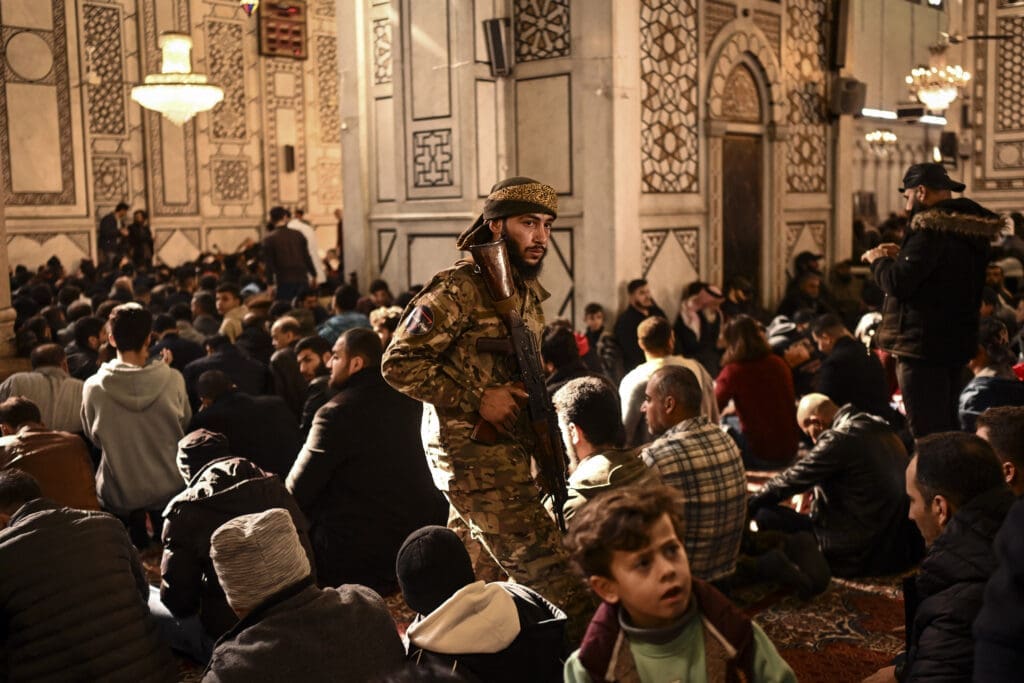The lightening quick takeover of Syria by Hayat Tahrir al-Sham (HTS) led-fighters in an offensive that began on November 27 and ousted the 54-year old Assad regime by December 8, has been stunning. Indeed, the speed of developments has left many observers with more questions than answers, including on the character of the rebel forces, and in particular their dominant faction. Yet the history of HTS is as tangled as the Syrian conflict itself. After eight years of evolving and adapting, the jihadist group formerly known as Jabhat al-Nusra has emerged at the head of a fragile arrangement of forces to seize control of the country, demonstrating its enduring power and influence.
This dramatic resurgence raises questions that extend far beyond the immediate battlefield. The case of HTS shows that while jihadist groups may suffer periods of decline, they are extremely resilient and malleable. Even when under immense existential pressure, jihadist groups don’t easily go away; they adjust, evolve and re-emerge in new forms, often exploiting power vacuums and unaddressed grievances. It is dangerous for governments in the region and outside it to underestimate them; history has shown that such groups often experience resurgence, frequently in unexpected ways and with renewed vigor.
How Jihadist Groups Defy Extinction
HTS was founded by Ahmed Hussein al-Shar’a, popularly known by his nom de guerre, Abu Mohammad al-Jolani. Dispatched to Syria by the Islamic State of Iraq (ISI) in 2011, al-Jolani quickly demonstrated his independent streak and strategic acumen. Between 2012 and 2013, he defied ISI instructions and focused on establishing Jabhat al-Nusra’s own territorial control in parts of northern and eastern Syria. This bold move laid the groundwork for HTS’s future autonomy. When ISI leader Abu Bakr al-Baghdadi declared the merger of the two groups into the Islamic State of Iraq and Syria (ISIS) in 2013, al-Jolani refused. He severed ties with ISIS and realigned the group with al-Qaeda, signaling a clear break and a strategic shift in allegiance. This early display of calculated decision-making highlights the group’s capacity to adapt and prioritize its interests, even in the face of pressure from more powerful actors like ISIS.
The shift was followed by yet another transformation in 2016. Rebranding as Jabhat Fath al-Sham, the group distanced itself from al-Qaeda—eschewing its transnational focus—to concentrate its efforts on the Syrian arena. Jabhat Fatah al-Sham continued its transformation in late January 2017, culminating in a merger with several other groups—Harakat Nour al-Din al-Zinki, Liwa al-Haq, Jaysh al-Sunna, and Jabhat Ansar al-Din—to form Hayat Tahrir al-Sham (HTS). This strategic evolution allowed HTS to embed itself more deeply into the Syrian context. By shifting allegiances and strategy, HTS was able to remain/enhance relevant within a localized context in which the battlelines had become static and activity was limited. Among jihadi groups, such adaptations are not altogether unique.
While the ability to adapt is crucial for the survival of any insurgent group, jihadist groups exhibit a unique blend of ideological fervor, decentralized structures, and savvy exploitation of local conditions that set them apart. Jihadist groups possess a remarkable ability to adapt and endure, drawing upon several key factors. First, their unwavering religious ideological commitment fuels their persistence in the face of setbacks. This commitment is rooted in a belief in a cause larger than themselves, such as the concept of the “Umma”, an imagined global Muslim community. Second, the decentralized structure of many jihadist networks safeguards them from decapitation strikes, as the loss of individual leaders does not cripple the entire organization. Third, their adeptness at exploiting local grievances and power vacuums allows them to garner support and recruits, ensuring their continued existence even when facing challenges. Finally, their effective use of propaganda and online radicalization enables them to maintain relevance and inspire attacks, even when facing territorial losses.
The case of Al-Qaeda in the Islamic Maghreb (AQIM) provides further evidence of this ability to evolve. AQIM’s roots lie in the violent crucible of the Algerian civil war between 1990 and 2000, specifically with the Salafist Group for Preaching and Combat (GSPC). The GSPC was founded by Abdelmalek Droukdel, also known as Abu Musaab Abdelwadud, who split from the notorious Armed Islamic Group (GIA) in the mid-1990s. Droukdel’s strategic decision to distance his brigade from the GIA’s campaign of extreme violence against civilians, which culminated in horrific massacres in the summer of 1997, proved crucial to its survival. He then established the GSPC, and further solidified its position by formally aligning with al-Qaeda in 2006 and rebranding as AQIM the following year.
This alliance brought increased resources, expanded international connections, and a broader platform to advance its jihadist agenda. Recognizing the limitations of its appeal within Algeria, AQIM expanded its operations into the Sahel in 2009. This strategic move aimed to exploit the porous border region and tap into potential support networks in neighboring countries. AQIM’s southward expansion was also driven by a strategic objective to unite various jihadist groups operating across the Sahel. This included factions like the Libyan Islamic Fighting Group and the Moroccan Islamic Combatant Group, aimed at creating a broader and more unified jihadist front. To effectively pursue this goal, Droukdel divided the Sahelian Branch into several battalions, or kataib, under the command of key figures like Mokhtar Bel Mokhtar, Abdelhamid Abu Zeid and Yahia Djaoudi. This proved successful, allowing AQIM to forge alliances with other militant groups like Ansar Eddine and the Movement for Oneness and Jihad in West Africa (MUJAO), thereby furthering its regional influence.
Under Droukdel’s command, AQIM displayed remarkable resilience, orchestrating a series of terrorist attacks, including bombings and kidnappings, targeting both Algerian and international interests. Critically, Droukdel learned from the GIA’s errors, actively seeking to avoid alienating the local population in the Sahel. Recognizing that the GIA’s brutality had fueled resentment and hindered its objectives, Droukdel advocated for a more gradual and strategic implementation of Islamic law. He emphasized “da’wa,” or missionary work, to win hearts and minds, and cautioned against the hasty imposition of harsh punishments like public lashings for adultery. Such actions, he argued, would only antagonize the population and undermine AQIM’s long-term goals.
Despite setbacks and the loss of key leaders, AQIM has continued to evolve and maintain its presence in the Sahel. Like HTS, AQIM serves as a potent reminder that these groups rarely simply vanish. They morph, adapt and forge new alliances in ways that allow them to endure setbacks and losses.
This is also true of much larger organizations like al-Qaeda and ISIS, which have managed to persist despite significant international military campaigns to eradicate them. Following the post-9/11 U.S.-led “war on terror” and the death of Osama bin Laden, al-Qaeda underwent a profound transformation. It decentralized its leadership structure, adopting a franchise model that empowered regional affiliates to operate with greater autonomy. This allowed al-Qaeda to maintain its global reach while reducing its vulnerability to decapitation strikes. Furthermore, it shifted its focus towards local conflicts and grievances, embedding itself within existing struggles and exploiting instability to gain support and recruits.
ISIS, faced with the loss of its territorial “caliphate” in Iraq and Syria, has similarly adapted. It has intensified its online presence, using sophisticated propaganda to radicalize and inspire lone wolf attacks across the globe. Simultaneously, ISIS has sought to exploit instability and conflict in other regions, particularly in Africa and South Asia, establishing new footholds and expanding its influence. This demonstrates a strategic shift towards a more decentralized insurgency, aimed at maintaining relevance and posing a persistent threat to global security, regional stability and civilian populations even without a physical caliphate—despite that being what previously set it apart from others.
Whether it’s al-Qaeda’s decentralization and focus on local conflicts, ISIS’s embrace of online radicalization and expansion into new territories, or HTS and AQIM’s strategic shifts and alliances, these groups have consistently proven their ability to evolve and endure. This defining feature poses a significant challenge for counterterrorism efforts, demanding a flexible and multifaceted approach that can anticipate and respond to the ever-changing nature of the jihadist threat.


